S-92A Offshore Landing Obstacle Strike: CENIPA Report (BHS S-92A PR-CHR on Sevan Brasil)
On 15 April 2017, Sikorsky S-92A PR-CHR of CHC‘s Brazilian Helicopter Services (BHS), under contract to Petrobras, suffered an obstacle strike and hard landing on the Sevan Brasil (SS-86), a Mobile Offshore Drilling Unit (MODU) off Brazil.

CHC Brazil / BHS Sikorsky S-92A PR-CHR After Obstacle Strike on Approach to Sevan Brasil (Credit: CENIPA)
None of the 21 occupants were injured in this accident, which was dramatically caught on video:
Brazilian accident investigation agency CENPIA published their safety investigation report, in Portuguese only, on 3 November 2022, a disappointing 5½ years later.
The Accident Flight
The offshore helicopter had departed Cabo Frio for the Sevan Brasil under VFR, with two pilots, a cabin attendant and 18 passengers.
CENIPA explain that the Aircraft Commander, who had flown 21,307 hours (3.294 on type) was sat in the left hand seat as an instructor & ‘Accredited Examiner’, and Pilot Monitoring (PM). In the right seat was a Pilot in Command Under Instruction (PICUS) who had 5,500 flying hours experience (253 on type) was Pilot Flying (PF). This was the flight crew’s third flight of the day. The Aircraft Commander had been PF for the first two offshore landings as the wind, and therefore the approach direction, favoured an approach best made by the left hand pilot. In fact the Aircraft Commander had made all landings in the previous three days they had flown together too.
Sevan Brasil is a relatively novel circular hull MODU with a D23, t15.6 helideck, adequate for helicopters up to the size of the AW101, mounted at c 150 ft above sea level. The octagonal helideck is not mounted tangentially.
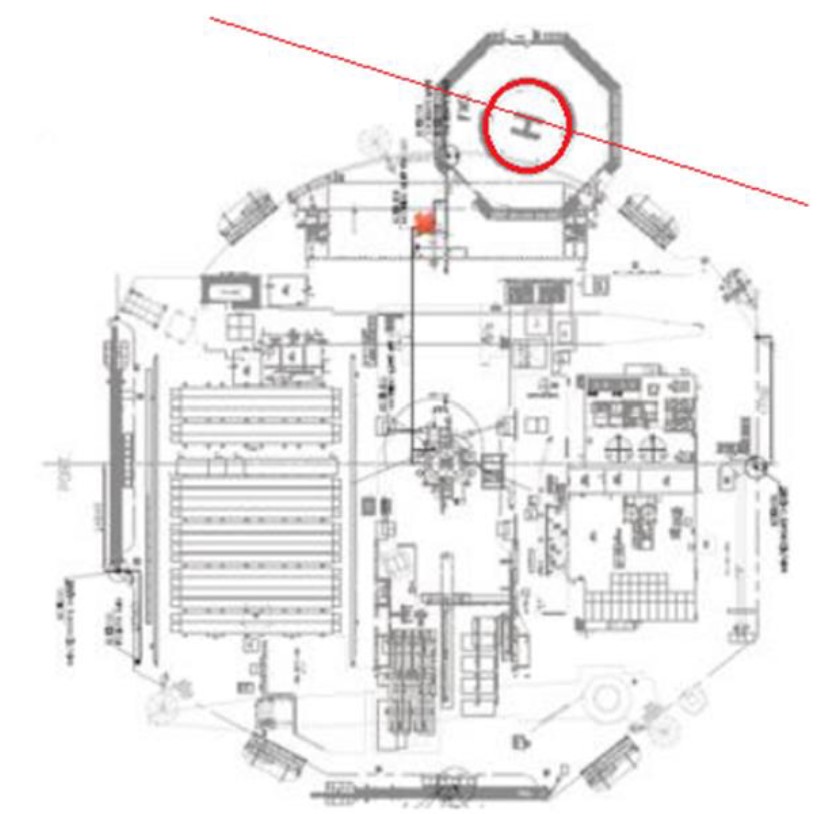
Sevan Brasil Layout (Credit: CENIPA)
CENPIA note the chevron marking that indicates the 210° Obstacle Free Sector (OFS) was incorrectly positioned. Though this is not relevant to this accident due to the chosen approach direction.

Sevan Brasil Helideck Design (left – correct) & as Painted (right – incorrect) (Credit: CENIPA)
More significantly, the helideck plate for the Sevan Brasil, which the crew consulted before departure, had…
…no information regarding the positioning of the chevron, 150º and 210º sector orientations, helideck bow, wind limitations, relative wind, etc.
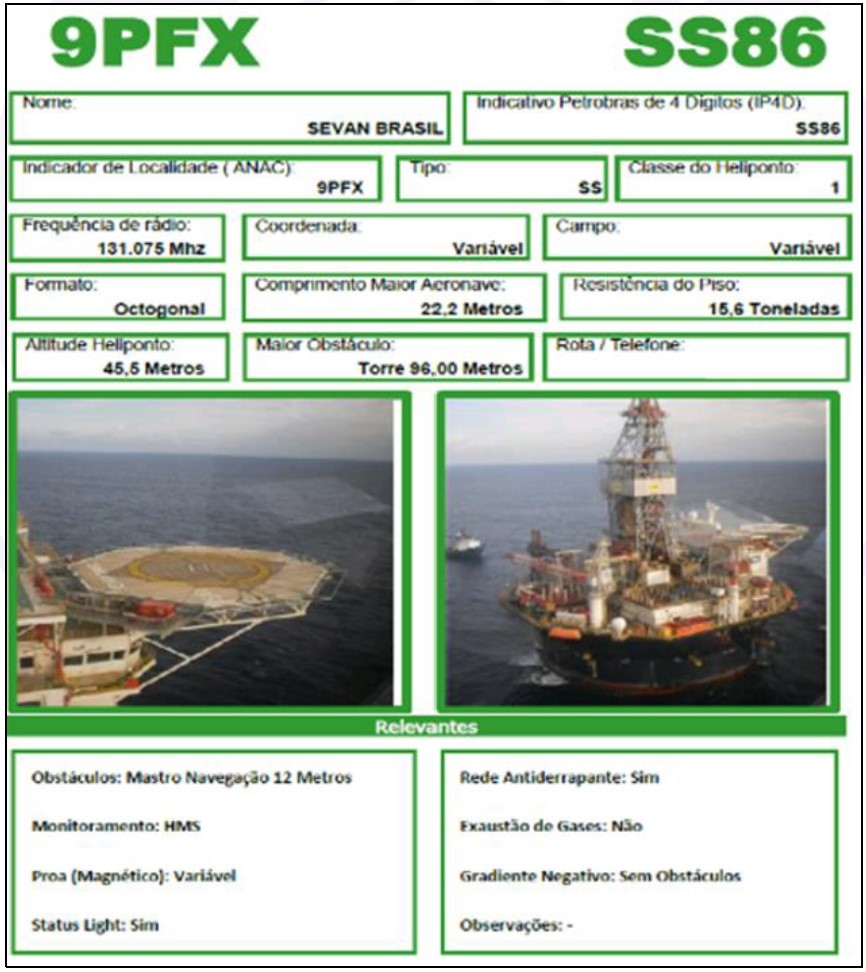
This deficiency is of note because CENIPA also reveal that the flight was due to have been flown by another helicopter company, implying the crew would be less familiar with the installation and more dependent of the plate for their orientation.
The investigators highlight that UK CAA CAP 437: Standards for offshore helicopter landing areas, probably the most widely referenced helideck standard, is far more explicit of the data that should be included.
CENPA also highlight whip antennas and structure near the helideck were not marked in accordance with guidance in NORMAM 27 (the Brazilian helideck standard). However, CENPIA also commented that the guidance was not explicit about how far from the helideck these markings were necessary.

Sevan Brasil Whip Antenna (Credit: CENIPA)
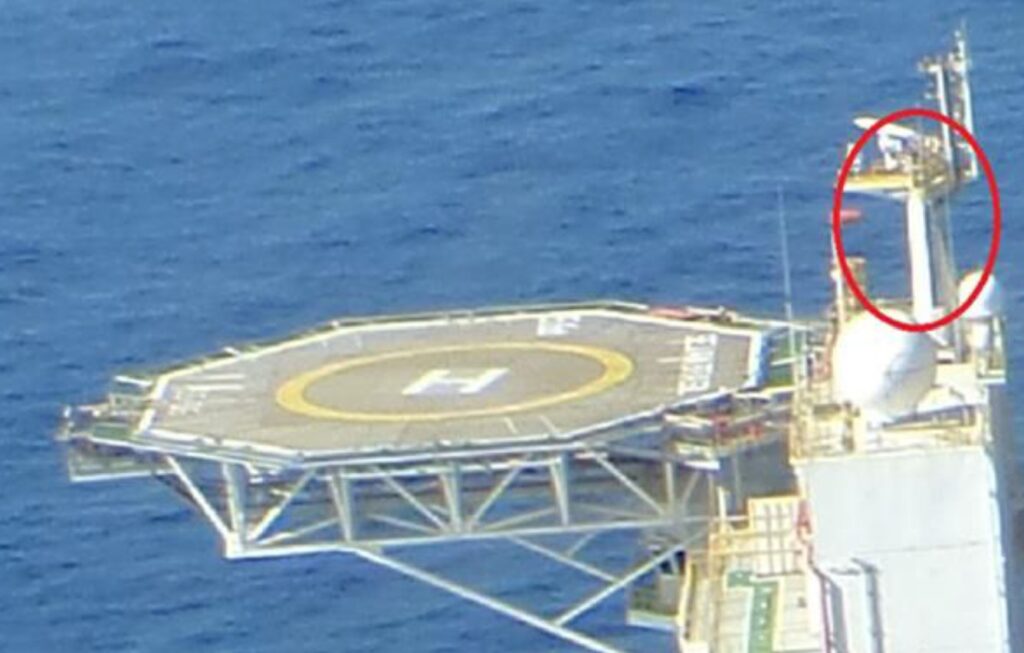
Sevan Brasil Radar Mast (Credit: CENIPA)
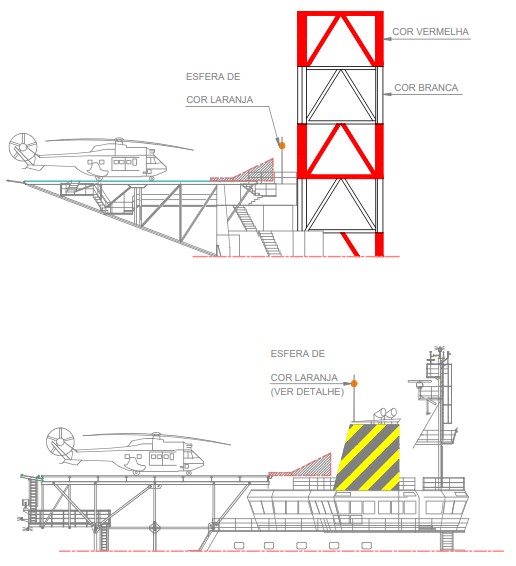
NORMAM 27 Obstacle Marking Guidance (Credit: Brazilian Navy)
The operator’s Operations Manual states that:
The Aircraft Commander should use his judgment and experience in selecting what he considers to be the best profile. Factors such as: aircraft weight; wind speed; turbulence; size of helideck; elevation and orientation helideck; obstructions; available power margins; platform gas burner flames; etc., will influence the takeoff and landing decision-making.
The Ops Manual goes on to list factors to consider such as
- Landing area location and wind direction;
- Wind strength;
- Experience level of each pilot; and
- Missed approach (go-around) profile.
In this case it was decided that the PICUS, sat in the right seat would be PF for this landing. The PICUS did express discomfort about the wind direction but the Aircraft Commander was not concerned and both crew agreed the PICUS would land from the right seat.
CENPIA say:
During the approach and overflight of the platform, the crew visually checked the conditions for landing, and both realized that the wind direction was more favourable for the Aircraft Commander to perform the landing.
However, the previous decision prevailed, that it would be made by the occupant of the seat on the right, although he had already shown concern about the direction and intensity of the wind.
Although not observed by CENIPA, this indicates a degree on continuation bias, where personnel stick to the original plan even when circumstances are inconsistent with their original planning assumptions.
Indeed during the approach both flight crew commented on the wind direction but the approach was continued. CENPIA comment on “informal conversations” also taking place and the Aircraft Commander briefly ‘humming’ (so not consistent with the sterile cockpit concept in the Operations manual).
In interview the crew highlighted there may have been confusion about the vessel’s heading and the wind direction relative to the vessel due to this being a circular vessel (a vessel type not covered in NORMAM 27).
The following two diagrams show firstly the approach undertaken from the right hand seat and an alternative that could have been flown into wind from the left hand seat.
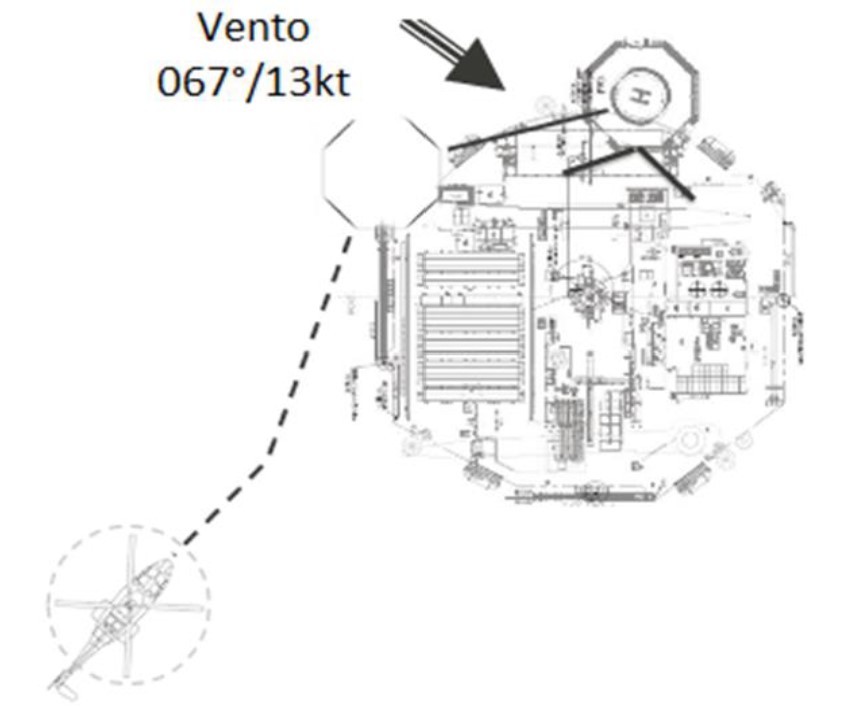
CHC Brazil / BHS Sikorsky S-92A PR-CHR Actual Approach to Sevan Brasil (Credit: CHC via CENIPA)

Alternative Approach to Sevan Brasil (Credit: CHC via CENIPA)
The approach chosen resulted in the helicopter transitioning across the installation with obstacles behind and out of view. The tail rotor contacted a radar antenna, blade debris appears to have severed the horizontal stabiliser and the aircraft made a hard landing sufficient for the left main landing gear to penetrate the upper sponson.

CHC Brazil / BHS Sikorsky S-92A PR-CHR Horizontal Stabiliser Failing after Tail Rotor Debris Impact Following an Obstacle Strike on Approach to Sevan Brasil (Credit: unknown)
CENIPA make little comment on the impact dynamics and although they indicate they replayed the CVR audio, there is no indication that FDR data was analysed. There is also no indication that FDM data was reviewed to establish ‘normality’.
Safety Action
The operator published a Safety Alert on the same day “in which it recommended that landing on the platform should be performed on the safest side”.
NORMAM 27 had been revised since, but CENPIA give no indication of what specific changes are relevant to this accident.
Conclusions & Observations
Ultimately this accident involved a desire for the right hand seat pilot to perform a landing to gain experience and a lack of clarity in the approach plate, resulting in a sub-optimal approach direction being selected, and then persisted with, indicating a continuation bias.
Safety Resources
The European Safety Promotion Network Rotorcraft (ESPN-R) has a helicopter safety discussion group on LinkedIn.
HeliOffshore, the global collaborative safety association for the offshore helicopter industry, founded in 2014, has issued a recommended practice on flightpath management. The HeliOffshore recommendations are explicitly addressed within the Flight Safety Foundation (FSF) Basic Aviation Risk Standard for Offshore Helicopter Operations (BARSOHO) in controls:
- 1.5 Multi-crew Operations
- 3.1 Flightpath Management
- 3.2 Effective Use of Automation
The BARSOHO controls align with the HeliOffshore Safety Performance Model and are detailed, well proven, contracting standards for offshore crew change flights, SAR. medevac and helicopter hoist operations.
You may also find these Aerossurance articles of interest:
- Review of “The impact of human factors on pilots’ safety behavior in offshore aviation – Brazil”
- HeliOffshore 2022 Conference Review
- Helideck Heave Ho! (BHS Sikorsky S-76C++ PR-CHI)
- Fatal GOM B407 Offshore Take Off Accident: Safety, Helideck & SAR / Emergency Response Questions
- 2009 Newfoundland S-92A C-GZCH Accident: A Failure of Design and Certification
- Fatal Mi-8 Loss of Control – Inflight and Water Impact off Svalbard
- Canadian Coast Guard Helicopter Accident: CFIT, Survivability and More
- Korean Kamov Ka-32T Fire-Fighting Water Impact and Underwater Egress Fatal Accident
- NH90 Caribbean Loss of Control – Inflight, Water Impact and Survivability Issues
- Dramatic Malaysian S-76C 2013 Ditching Video
- Ditching after Blade Strike During HESLO from a Ship
- US BSEE Helideck A-NPR / Bell 430 Tail Strike
- AS350B3 Ditching Japan
- GOM Helicopter Ops 2000-2019: Single Engine Usage Plummets But Fatal Accident Rate Resistant
- S-92A Collision with Obstacle while Taxying
- Loss of Bell 412 off Brazil Remains Unexplained
- Offshore Night Near Miss: Marine Pilot Transfer Unintended Descent
- North Sea Helicopter Struck Sea After Loss of Control on Approach During Night Shuttling (S-76A G-BHYB 1983)
- Wrong Deck Landings
- NTSB Report on Bizarre 2012 US S-76B Ditching
- FOD and an AS350B3 Accident Landing on a Yacht in Bergen
- Night Offshore Training AS365N3 Accident in India 2015
- Loss of Control, Twice, by Offshore Helicopter off Nova Scotia
- Night Offshore Windfarm HEMS Winch Training CFIT (BK117C1 D-HDRJ)
- Blinded by Light, Spanish Customs AS365 Crashed During Night-time Hot Pursuit
- UPDATE 11 February 2023: Urgent Exit Required: A Helideck Incident (Omni Sikorsky S-76C+ PR-SEC)
We have discussed human factors and error management more generally here:
- Professor James Reason’s 12 Principles of Error Management
- Back to the Future: Error Management
- Also see our review of The Field Guide to Understanding Human Error by Sidney Dekker presented to the Royal Aeronautical Society (RAeS): The Field Guide to Understanding Human Error – A Review
A public inquiry chaired by Anthony Hidden QC investigated 1988 Clapham Junction rail accident. In the report of the investigation, known as the Hidden report, he commented:
There is almost no human action or decision that cannot be made to look flawed and less sensible in the misleading light of hindsight. It is essential that the critic should keep himself constantly aware of that fact.

Recent Comments